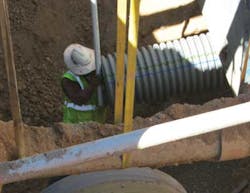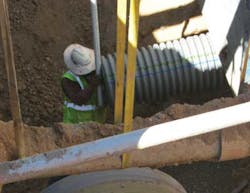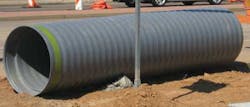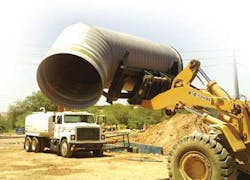Photo courtesy of ADS
In Chandler, AZ, the intersection of Dobson Road and Chandler Boulevard is right in the thick of the city's main thoroughfare where the weekday daily traffic load tops 40,000 vehicles.
Photo courtesy of ADS
Under a $4.5 million road widening project, Standard Construction Co. (Avondale, AZ) was awarded a contract to reconstruct the intersection that included dual left turn lanes, a third auxiliary through lane, right turn lanes, bike lanes, bus pullouts, the storm drain, water line, new traffic signals, streetlights and landscaping. Now a total of six lanes, the intersection was completed in January 2011 and utilized $2.3 million in federal stimulus funds provided by the American Recovery and Reinvestment Act.
Burial depth for the project's stormwater drainage line was specified at 18 feet for the retention basin to a minimum of three feet at collection points. At some points the bottom of the pipe was 26 feet deep.
According to Steve Sutton, president of Standard, "The pipe had to perform in deep and shallow depths."
The project was originally specified to use rubber-gasketed reinforced concrete pipe (RCP). But to help control costs and meet the deep burial requirements, Standard proposed using a highly engineered corrugated pipe.
"Up until now, the city standards specified concrete pipe as the approved material. They didn't typically allow HDPE pipe," Sutton said. "In fact, the Chandler road project was originally designed with concrete pipe but there was an interest in finding out more about the corrugated pipe. We proposed it as a valued engineering product which saved them about 10 percent of the cost of the pipe portion of this project."
Photo courtesy of ADS
The city chose N-12 High Performance (HP) corrugated pipe from Advanced Drainage Systems (ADS; Hilliard, OH). The pipe selection was independently reviewed by civil and environmental engineering firm Engineering and Environmental Consultants (EEC; Tucson, AZ). According to Carrie Cote, P.E., project manager at the firm, the pipe was presented by the contractor as an alternative that was comparable to RCP in purpose, strength and capability.
"The contractor believed it would also save some money," she said. "But the city wanted to make sure it satisfied their specifications so we got involved, reviewed it and approved that type of pipe."
Made from an engineered grade of polypropylene resin, the pipe is designed and manufactured to handle heavy dead and AASHTO designated live loads without additional bedding or special fill. More than 1,840 feet of the pipe was used in diameters ranging from 12 to 60 inches. In one area, the 60-inch diameter corrugated pipe is covered by 21 feet of fill.
"Chandler wanted the high performance pipe because of the deep burial depths," said Steve Blake, operations manager for Standard. "Even though we were down so deep, we didn't have to make any special arrangements for bedding or compaction. But since the engineer did want a little more bedding than the manufacturer's recommendation, we ended up going with gravel instead of slurry to the spring line and then went gravel to a foot above."
Photo courtesy of ADS
The pipe's light weight was also an advantage. "It's maneuverable because it's lighter and you can lay the pipe with smaller equipment," said Blake. "We were able to move the pipe sections a lot faster because of the longer lengths of pipe."
"The fittings just snap together and we didn't have to do anything special with them," Blake said. "The pipe is more forgiving as far as relocating it because you can cut it and shorten the length or change the location of where you put the pipe and you don't have to use a crane. The concrete pipe requires more time, more manpower and heavy equipment. You have more sections and install it in small eight-foot increments so it's naturally a slower process."
The Chandler project was the first public right-of-way project in the state of Arizona to use the N-12 HP pipe, due in large part to the independent engineering evaluation. As a result, the HP pipe can now be specified for right-of-way road work in the City of Chandler.
"As for the future of the HP pipe," Sutton said, "there is a time and a place for everything. For this application at the busiest intersection in Chandler, it worked really well and I'm sure the city will use more of it in other places also. We're looking forward to using the HP pipe again."
WaterWorld Articles Archives







